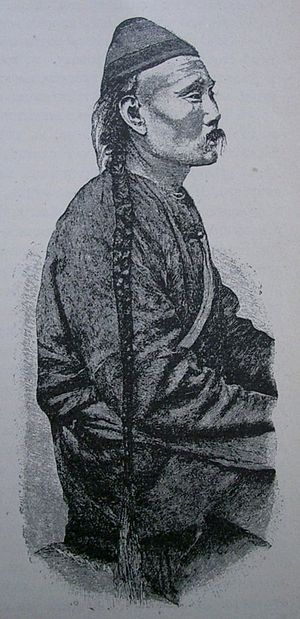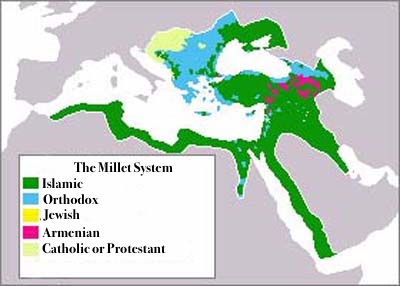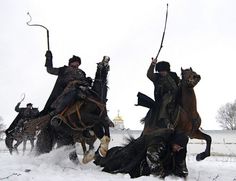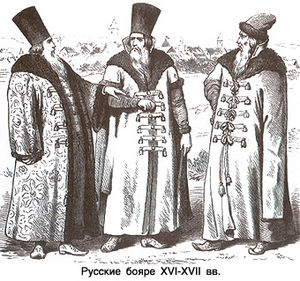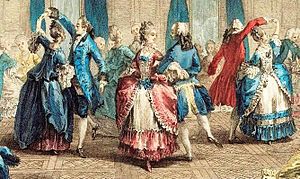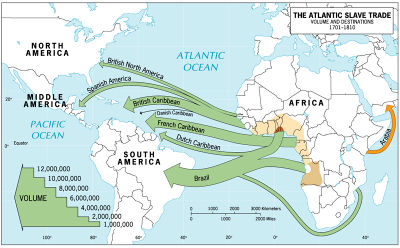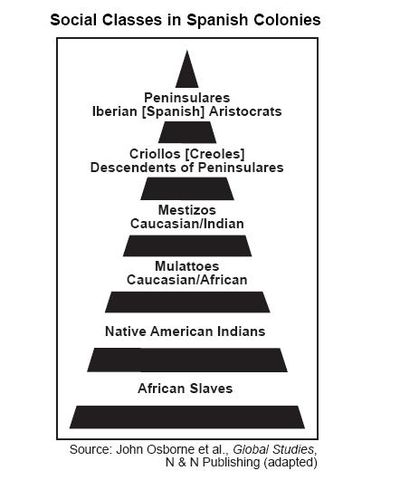Topic 4.7 Changing Social Hierarchies 1450 to 1750
Jump to navigation
Jump to search
As we have seen since the earliest empires, the territorial growth of states invites the problems of ruling a large multi-ethnic empire. The most successful states found ways to incorporate ethnic and cultural minorities in a way that permitted the state to benefit from their presence while at the same time limiting their political influence. Between 1450 and 1750 there were several examples of states attempting this balancing act.
- Ottomans and their non-Muslim subjects After the fall of Constantinople in 1453 the Ottoman empire absorbed the former Byzantine lands and the number of Christians under Ottoman rule greatly increased. By the middle of the 1500s the non-Muslim population of the empire reached about 40%. [1] To deal with the increasing diversity of the Empire, Mehmet II introduced what would later be called the millet system. Each millet, from the Arabic word for nation, was an autonomous zone made up of a particular religious group. [2] Each millet was permitted to chose its own leader, practice its own religion, and live by its own religious orders or rules; Sharia law did not have effect within a non-Muslim millet. For example, Orthodox Christians and Jews each had their own respective millets and lived according to their own customs. An influence on the development of non-Muslim millets was that members were not allowed to hold military or political posts. Thus their impact on the Islamic character of the Empire was limited. Consequently, Christian and Jewish millets turned to the development of craft skills, finance and brokerage. [3] They became important intermediaries in trade negotiations with merchants outside the empire benefitting the Ottoman economy.
- Ottomans and their non-Muslim subjects After the fall of Constantinople in 1453 the Ottoman empire absorbed the former Byzantine lands and the number of Christians under Ottoman rule greatly increased. By the middle of the 1500s the non-Muslim population of the empire reached about 40%. [1] To deal with the increasing diversity of the Empire, Mehmet II introduced what would later be called the millet system. Each millet, from the Arabic word for nation, was an autonomous zone made up of a particular religious group. [2] Each millet was permitted to chose its own leader, practice its own religion, and live by its own religious orders or rules; Sharia law did not have effect within a non-Muslim millet. For example, Orthodox Christians and Jews each had their own respective millets and lived according to their own customs. An influence on the development of non-Muslim millets was that members were not allowed to hold military or political posts. Thus their impact on the Islamic character of the Empire was limited. Consequently, Christian and Jewish millets turned to the development of craft skills, finance and brokerage. [3] They became important intermediaries in trade negotiations with merchants outside the empire benefitting the Ottoman economy.
- Manchus and their Chinese subjects In East Asia the Manchus, descendants of the Jurchen, overthrew the corrupt Ming and established the Qing Dynasty placing China once again under the yoke of a foreign ethnic group. The Qing dynasty expanded Chinese territory larger than it ever had been before and ruled a population of 450 million people. [4] Unlike previous Chinese dynasties, the Qing did not impose Chinese language or culture over their subjects and thought of China as just one part of a larger Manchu empire. [5] They adopted a policy of "ruling different people differently," allowing local languages, customs, and in some cases, permitting local leaders to maintain leadership positions. The Manchus strove to keep themselves racially separate from the ethnic Chinese (the Han). Chinese were forbidden to learn the Manchu language and prohibited from traveling to the Manchu homeland where they might learn it. Marriage between Manchu and Han was illegal. [6] With ethnic lines clearly drawn, Manchus got preferential treatment. There was a separate court system for Manchus and prosecuting them was very difficult. If convicted, Manchus got reduced punishments and had prison cells separate from those used for all other prisoners. Although Manchus were the most favored group in the imperial bureaucracy, Chinese were allowed to take governing posts along with Manchus. Allowing Chinese to earn positions in the bureaucracy through civil service examinations rendered Manchu rule more acceptable for Chinese. However, the highest point to which a Chinese civil servant could rise, was an executive position known as a "grand secretary." These administrators had no policy making power; they served as channels of communication "by ratifying, and forwarding 'memorials,' reports sent to the emperor from other central and field offices." [7] The highest central administrative positions in Beijing, of course, were reserved for Manchus who were paid salaries in silver, not copper coins like other ethnic groups were paid. [8] And to prevent Chinese from dominating the bureaucracy, it was much easier for Manchus to gain appointments and rise through the ranks.
- Manchus and their Chinese subjects In East Asia the Manchus, descendants of the Jurchen, overthrew the corrupt Ming and established the Qing Dynasty placing China once again under the yoke of a foreign ethnic group. The Qing dynasty expanded Chinese territory larger than it ever had been before and ruled a population of 450 million people. [4] Unlike previous Chinese dynasties, the Qing did not impose Chinese language or culture over their subjects and thought of China as just one part of a larger Manchu empire. [5] They adopted a policy of "ruling different people differently," allowing local languages, customs, and in some cases, permitting local leaders to maintain leadership positions. The Manchus strove to keep themselves racially separate from the ethnic Chinese (the Han). Chinese were forbidden to learn the Manchu language and prohibited from traveling to the Manchu homeland where they might learn it. Marriage between Manchu and Han was illegal. [6] With ethnic lines clearly drawn, Manchus got preferential treatment. There was a separate court system for Manchus and prosecuting them was very difficult. If convicted, Manchus got reduced punishments and had prison cells separate from those used for all other prisoners. Although Manchus were the most favored group in the imperial bureaucracy, Chinese were allowed to take governing posts along with Manchus. Allowing Chinese to earn positions in the bureaucracy through civil service examinations rendered Manchu rule more acceptable for Chinese. However, the highest point to which a Chinese civil servant could rise, was an executive position known as a "grand secretary." These administrators had no policy making power; they served as channels of communication "by ratifying, and forwarding 'memorials,' reports sent to the emperor from other central and field offices." [7] The highest central administrative positions in Beijing, of course, were reserved for Manchus who were paid salaries in silver, not copper coins like other ethnic groups were paid. [8] And to prevent Chinese from dominating the bureaucracy, it was much easier for Manchus to gain appointments and rise through the ranks.
The world experienced such dramatic upheavals of conquest, the movement of wealth, and new connections that societies experienced significant restructuring. In some cases new ethnic groups rose to the top of society thus replacing traditional elites.
- Mughal Zamindars Another group whose power fluctuated in this time was the zamindars of the Mughal Empire. Like the boyars in Russia, zamindars were intermediaries between rulers and the ruled. They performed the function of aristocrats. The Mughal state had the zamindars collect tribute from peasants and allowed them to keep 10 percent of it themselves before sending it to the government. Tribute was paid in kind, in the form of crops, rice, pepper, or some other agricultural product. As with all aristocrats with local authority, zamindars constituted a potentially decentralizing force. Revenues to the state began to drop because the zamindars were keeping much of this tribute for themselves; peasants resented them for growing rich at their expense. Emperor Akbar reformed this system of taxation in a way that both ensured higher revenues for the state as well as centralizing the power of the government. With an abundance of Spanish silver now available in Asia, Akbar monetized the tax system, requiring peasants to pay taxes in currency rather than in agricultural produce. To do this they were required to take their harvest to special state monitored markets to sell for cash which was then used to pay taxes directly to the government. No longer tribute collecting lords, the zamindars had been circumvented and the state more centralized. Many of them became servants of the state. [9]
- Mughal Zamindars Another group
- Spanish America and the República de Indios In colonial America, Spanish administrators sought to adapt and impose the social structure of Iberia. Back home, society was organized into large corporate groups with different levels of rights and privileges adhering to each group rather than to individuals. In the New World the Spanish likewise divided the population into two primary groups. The first group was the república de espanoles comprised of all Iberian born people, Spanish creoles, and anyone else of mixed Spanish race. The other group was the república de indios made up of the non mestizo indigenous population. This separation was initially made to protect indigenous people from the harness of the Spaniards; [10] they were divided into independent communities ruled by their own elites, and they enjoyed their own separate system of courts and laws. The system failed because of Spanish demand for indigenous labor. República de Indios were required to supply labor through the mita system to American silver mines. The became the target of the labor draft in Mexico known as the repartimiento which supplied labor to commercial farms, mines, and select private enterprises. Their required tribute payments became an important source of revenue for the Spanish colonial governments. The continued flow of people between the república de espanoles and the república de indios eventually blurred their distinctive identities. [11]
- Spanish America and the República de Indios In colonial America, Spanish administrators sought to adapt and impose the social structure of Iberia. Back home, society was organized into large corporate groups with different levels of rights and privileges adhering to each group rather than to individuals. In the New World the Spanish likewise divided the population into two primary groups. The first group was the república de espanoles comprised of all Iberian born people, Spanish creoles, and anyone else of mixed Spanish race. The other group was the república de indios made up of the non mestizo indigenous population. This separation was initially made to protect indigenous people from the harness of the Spaniards; [10] they were divided into independent communities ruled by their own elites, and they enjoyed their own separate system of courts and laws. The system failed because of Spanish demand for indigenous labor. República de Indios were required to supply labor through the mita system to American silver mines. The became the target of the labor draft in Mexico known as the repartimiento which supplied labor to commercial farms, mines, and select private enterprises. Their required tribute payments became an important source of revenue for the Spanish colonial governments. The continued flow of people between the república de espanoles and the república de indios eventually blurred their distinctive identities. [11]
Examples of the rise of new elites
- Creoles in Spanish America Having just driven the Moors and Jews out of Iberia, the Spanish Conquistadors who came to the Americas were very conscious of race. The class system they established there combined the racial prejudices of Europeans with the unique circumstances of the New World. The Spanish exercised power in their American empire primarily though large landed estates (see encomienda above) though which they controlled indigenous labor and collected tribute. The owners of these estates were creoles, people of pure Spanish descent for whom the New World was their permanent home. Although peninsulares, viceroys and other bureaucrats on assignment from Spain, continued to be the colonial connection to the crown back in Europe, creoles better understood the day-to-day management of the colonies and developed their own colonial culture. The new creole elites worked in close relationship with the Roman Catholic Church which served to reinforce the hierarchical and patriarchal social order of the colonies. [12] Needless to say, the creoles grew to resent the peninsulares. They would be the driving force for independence in the revolutionary period.
- In addition to the rise of new elites, some empires experienced a fluctuation in power of existing elites. These traditional political and economic elites were used to being able to influence the political leaders of their empires but found it increasingly difficult to do so.
- In addition to the rise of new elites, some empires experienced a fluctuation in power of existing elites. These traditional political and economic elites were used to being able to influence the political leaders of their empires but found it increasingly difficult to do so.
- Examples of fluctuating power of existing elites:
- Examples of fluctuating power of existing elites:
- Russian Boyars The territorial conquests of Ivan III and Ivan IV had extended the borders of Russia before its political institutions had been fully developed; Russia was an empire before it was a state. Most power resided in local aristocrats called boyars, a class of people Ivan IV (Ivan "The Terrible") deeply distrusted. He shared the belief that the Byzantine Empire fell because of the "feuding, and disloyalty of it aristocrats, which had made it impossible to present a united front against Ottoman aggression." [13] Both Ivans sought to weaken the boyars and create a more centralized state. Ivan III deported and executed thousands of boyars in the city of Novgorad and replaced them with individuals who held their power on condition of service to him. [14] His grandson, Ivan IV applied this policy to a much larger portion of the empire. Boyars were exiled from their estates, thus cut off from their source of wealth and their ability to marshal local military power. Inspired in part by the Ottoman janissaries, Ivan IV created a policing army directly under his authority and not subject to local aristocratic oversight. But unlike the janissaries, the oprichnina, as they were called, could kill with impunity and terrorized much of the empire. When Ivan IV died, the empire was unstable, demoralized, and the boyars were eager to reassert their provincial powers.
- Russian Boyars The territorial conquests of Ivan III and Ivan IV had extended the borders of Russia before its political institutions had been fully developed; Russia was an empire before it was a state. Most power resided in local aristocrats called boyars, a class of people Ivan IV (Ivan "The Terrible") deeply distrusted. He shared the belief that the Byzantine Empire fell because of the "feuding, and disloyalty of it aristocrats, which had made it impossible to present a united front against Ottoman aggression." [13] Both Ivans sought to weaken the boyars and create a more centralized state. Ivan III deported and executed thousands of boyars in the city of Novgorad and replaced them with individuals who held their power on condition of service to him. [14] His grandson, Ivan IV applied this policy to a much larger portion of the empire. Boyars were exiled from their estates, thus cut off from their source of wealth and their ability to marshal local military power. Inspired in part by the Ottoman janissaries, Ivan IV created a policing army directly under his authority and not subject to local aristocratic oversight. But unlike the janissaries, the oprichnina, as they were called, could kill with impunity and terrorized much of the empire. When Ivan IV died, the empire was unstable, demoralized, and the boyars were eager to reassert their provincial powers.
- European Nobles In the monarchies of western Europe, the nobles (or, aristocrats) were the intermediary elites linking the ruler with the ruled. Aristocratic families possessed official titles of nobility and drew their wealth from large estates inherited through the family line of descent for centuries. They had control over the land, the peasants who worked it, and over the retainers (knights) who they could mobilize for defense. This group was at once both necessary and problematic for kings: necessary because they pulled together men and resources to fend off external rivals; problematic because they could act together to challenge the power of the king. [15] In the 1500s every European monarch, from England to Russia, attempted to reorganize this arrangement of elites in order to increase the power and security of the state. [16] Silver mines in the Americas, where there were no entrenched aristocratic families, meant the king did not have to depend as strongly on the aristocrats in Spain to fund his military campaigns. [17] In France, kings sold titles of nobility to non-aristocratic families in order to generate income. Needless to say, the traditional aristocratic families who possessed their wealth and titles for centuries looked down upon the new nobles who bought their way into privilege. Both groups despised the "vulgar" wealth of the middle class which had been obtained through craftwork, trade, and investments. Yet this former group was growing increasingly wealthy and more relevant to the economic realities of the world. Many aristocrats declined in influence and fell into enormous debt. An Englishman noted in 1628 that "the House of Commons could buy the House of Lords three times over." [18] Economic changes had set in motion a gradual process of social transformation in which the aristocracy, with its inherited wealth and titles, was becoming less relevant than those whose wealth was made through joint stock companies, craft work and trade.
- European Nobles In the monarchies of western Europe, the nobles (or, aristocrats) were the intermediary elites linking the ruler with the ruled. Aristocratic families possessed official titles of nobility and drew their wealth from large estates inherited through the family line of descent for centuries. They had control over the land, the peasants who worked it, and over the retainers (knights) who they could mobilize for defense. This group was at once both necessary and problematic for kings: necessary because they pulled together men and resources to fend off external rivals; problematic because they could act together to challenge the power of the king. [15] In the 1500s every European monarch, from England to Russia, attempted to reorganize this arrangement of elites in order to increase the power and security of the state. [16] Silver mines in the Americas, where there were no entrenched aristocratic families, meant the king did not have to depend as strongly on the aristocrats in Spain to fund his military campaigns. [17] In France, kings sold titles of nobility to non-aristocratic families in order to generate income. Needless to say, the traditional aristocratic families who possessed their wealth and titles for centuries looked down upon the new nobles who bought their way into privilege. Both groups despised the "vulgar" wealth of the middle class which had been obtained through craftwork, trade, and investments. Yet this former group was growing increasingly wealthy and more relevant to the economic realities of the world. Many aristocrats declined in influence and fell into enormous debt. An Englishman noted in 1628 that "the House of Commons could buy the House of Lords three times over." [18] Economic changes had set in motion a gradual process of social transformation in which the aristocracy, with its inherited wealth and titles, was becoming less relevant than those whose wealth was made through joint stock companies, craft work and trade.
- In addition to the rise of new elites and the fluctuating power of intermediaries, this era saw demographic, gender, and family changes as well. In Africa, the slave trade caused a significant demographic change. Between 1500 and 1900 approximately 10 million slaves were taken from Africa's west coast to labor in the Americas. During that same time, 6 million left the east coast as slaves in Asia and 8 million were enslaved within the African continent. [19] The result was that just as European and Asian populations were increasing due to the transferring of new crops (The Columbian Exchange), Africa saw a significant decline in population. Moreover, since there was an emphasis placed on having male slaves for sugar plantations in the Americas, the drain of slaves on the west African coast had a strong gender dimension. Places hit hardest by the slave trade, such as Angola, experienced a catastrophic gender imbalance with females comprising up to 65 percent of the population. [20]
- In addition to the rise of new elites and the fluctuating power of intermediaries, this era saw demographic, gender, and family changes as well. In Africa, the slave trade caused a significant demographic change. Between 1500 and 1900 approximately 10 million slaves were taken from Africa's west coast to labor in the Americas. During that same time, 6 million left the east coast as slaves in Asia and 8 million were enslaved within the African continent. [19] The result was that just as European and Asian populations were increasing due to the transferring of new crops (The Columbian Exchange), Africa saw a significant decline in population. Moreover, since there was an emphasis placed on having male slaves for sugar plantations in the Americas, the drain of slaves on the west African coast had a strong gender dimension. Places hit hardest by the slave trade, such as Angola, experienced a catastrophic gender imbalance with females comprising up to 65 percent of the population. [20]
- In Southeast Asia, which had long been a crossroad of trans-regional trade, a very different change in gender relations was occurring. For a long time, merchants arriving to this area discovered that local women were the essential key to doing business. Through a traditional practice called temporary marriage, merchants entered into relationships with local women that were mutually benefiting to both parties: merchants gained access to local markets and products, learned of indigenous practices and conditions, and gained sexual relations; the women gained gifts, support for their children, and connections to outside trading networks. When the merchant moved on, these marriages could be terminated and the women were free to pursue another such connection with no negative stigma or loss of social status. [21] These reciprocating relationships allowed some women to create impressive networks of trade and weld considerable power on local politics. In this era, however, the increasing involvement of European and Islam merchants reduced the instances of temporary marriages and, along with them, the economic influence of women.
- In Southeast Asia, which had long been a crossroad of trans-regional trade, a very different change in gender relations was occurring. For a long time, merchants arriving to this area discovered that local women were the essential key to doing business. Through a traditional practice called temporary marriage, merchants entered into relationships with local women that were mutually benefiting to both parties: merchants gained access to local markets and products, learned of indigenous practices and conditions, and gained sexual relations; the women gained gifts, support for their children, and connections to outside trading networks. When the merchant moved on, these marriages could be terminated and the women were free to pursue another such connection with no negative stigma or loss of social status. [21] These reciprocating relationships allowed some women to create impressive networks of trade and weld considerable power on local politics. In this era, however, the increasing involvement of European and Islam merchants reduced the instances of temporary marriages and, along with them, the economic influence of women.
- In the 17th century, foreign merchants brought with them different cultural views of marriage. Europeans and Chinese concepts of marriage were more restrictive and the expectation was, especially from Christian and Muslim merchants, that reputable women remain chase. However, these merchants still sought sexual relations with women. As a result, temporary marriages declined along with the opportunities they gave women for economic and political influence. The sexual relations once provided through temporary marriages now came from impoverished girls selling sexual favors to foreign merchants for cash. Foreign businessmen began to purchase these girls as sex slaves to profit from their clients. Scholars who research prostitution in modern Southeast Asia today increasingly link it historically to this transformation. [22]
- In the 17th century, foreign merchants brought with them different cultural views of marriage. Europeans and Chinese concepts of marriage were more restrictive and the expectation was, especially from Christian and Muslim merchants, that reputable women remain chase. However, these merchants still sought sexual relations with women. As a result, temporary marriages declined along with the opportunities they gave women for economic and political influence. The sexual relations once provided through temporary marriages now came from impoverished girls selling sexual favors to foreign merchants for cash. Foreign businessmen began to purchase these girls as sex slaves to profit from their clients. Scholars who research prostitution in modern Southeast Asia today increasingly link it historically to this transformation. [22]
- The family was changing in Europe as well. Economic changes in this era began a transformation of family patterns which would become much more prominent in the industrial age. European families decreased in size, particularly in urban centers. An agricultural based society thrives on large and extended families, as each member contributes to the family's production of food. In middle class urban families, children tend to be an expense for a longer period of time. As a consequence, the fertility rate was smaller in urban societies. Men and women also tended to marry latter in life, usually into their twenties, a sharp contrast to agricultural marriages which took place at an earlier age. As people began to earn money through crafts, trade and investments, a single set of parents and their children grew to be economically independent from the larger extended family. The nuclear family, as this was called, was less tied to property ownership and more emotionally centered. [23]
- The family was changing in Europe as well. Economic changes in this era began a transformation of family patterns which would become much more prominent in the industrial age. European families decreased in size, particularly in urban centers. An agricultural based society thrives on large and extended families, as each member contributes to the family's production of food. In middle class urban families, children tend to be an expense for a longer period of time. As a consequence, the fertility rate was smaller in urban societies. Men and women also tended to marry latter in life, usually into their twenties, a sharp contrast to agricultural marriages which took place at an earlier age. As people began to earn money through crafts, trade and investments, a single set of parents and their children grew to be economically independent from the larger extended family. The nuclear family, as this was called, was less tied to property ownership and more emotionally centered. [23]
- All of the above examples demonstrate how the power of existing elites fluctuated or how gender and family structures shifted during this era. There were some cases, however, in which entirely new ethnic and racial classifications emerged. The Spanish conquest of the Americas provide some of the most prominent examples of this change. Unlike the settler colonies of North America, which mostly attracted families from England seeking to find religious havens, South America attracted conquistadors, adventurers, and fortune hunters. Thus it had a higher percentage of single male colonists and, consequently, more likely to produce children of mixed ethnicities. Thus in Latin America peninsulares, aristocrats from Europe, were at the top of the social system. Next were creoles, people of pure European blood who were permanent residents in the American colonies. They often resented the peninsulares who were their superiors but whom the creoles thought knew less about the day to day management of the colonies than they did. The racial mixing between these groups of Europeans on one hand and indigenous people and slaves on the other, created the classifications of mestizo and mulatto as can be seen in the table to the right.
References
- ↑ Ottoman Brothers: Muslims, Christians, and Jews in Early Twentieth-Century Palestine, Michelle Campos (2011), p. 9.
- ↑ http://lostislamichistory.com/non-muslim-rights-in-the-ottoman-empire/
- ↑ Introduction to the Modern Economic History of the Middle East, Z. Y. Hershlag (1997) p. 25.
- ↑ Empires and Bureaucracy in World History: From Late Antiquity to the Twentieth Century, Peter Crooks, Timothy H. Parsons (2016) p. 33.
- ↑ Voyages in World History, Valerie Hansen, Kenneth R. Curtis (2016) p. 596.
- ↑ "Traditions and Encounters," (2011) 5th ed., Jerry Bentley, p. 575.
- ↑ China's Last Empire: The Great Qing, William T. Rowe (2010) p. 34.
- ↑ "The Manchu Way," (2001) Elliott, p. 197.
- ↑ Worlds Together, Worlds Apart, (2014), Robert Tignor et al., p. 470.
- ↑ Conquest and Survival in Colonial Guatemala, Fourth Edition: A Historical Geography of the Cuchumatán Highlands, 1500-1839, W. George Lovell (2015).
- ↑ Iberia and the Americas: Culture, Politics, and History: A Multidisciplinary Encyclopedia, vol 1. John Michael Francis (2006) pp. 901-902.
- ↑ "The History of Latin America: Collision of Cultures," (2007), Marshal Eakin, p. 143.
- ↑ Russia and the Russians: A History," (2011), Geoffrey Hoskings, p. 110.
- ↑ A Brief History of Russia," (2008), Michael Kort, p. 25.
- ↑ Empires in World History: Power and the Politics of Difference, (2010), Jan Burbank and Frederick Cooper, p. 146.
- ↑ European Society: 1500-1700, (1984), Henry Kamen, p. 94.
- ↑ Empires in World History, (2010), Burbank, p. 147.
- ↑ European Society, (1984), Kamen, p. 111.
- ↑ The Atlantic Slave Trade: Effects on Economies, Societies and Peoples in Africa, the Americas, and Europe, (1992), Joseph E. Inikori, p. 119-20.
- ↑ The Atlantic Slave Trade, (1992), Inikori, p. 120.
- ↑ Women in Asia: Restoring Women to History', (1999), Barbara N. Ramusack, Sharon L. Sievers, p. 89.
- ↑ Women in Asia, Barbara and Sievers, p. 90.
- ↑ World Civilizations: The Global Experience, (2007), 5th ed.,Peter N. Stearns, et al., p. 372.
